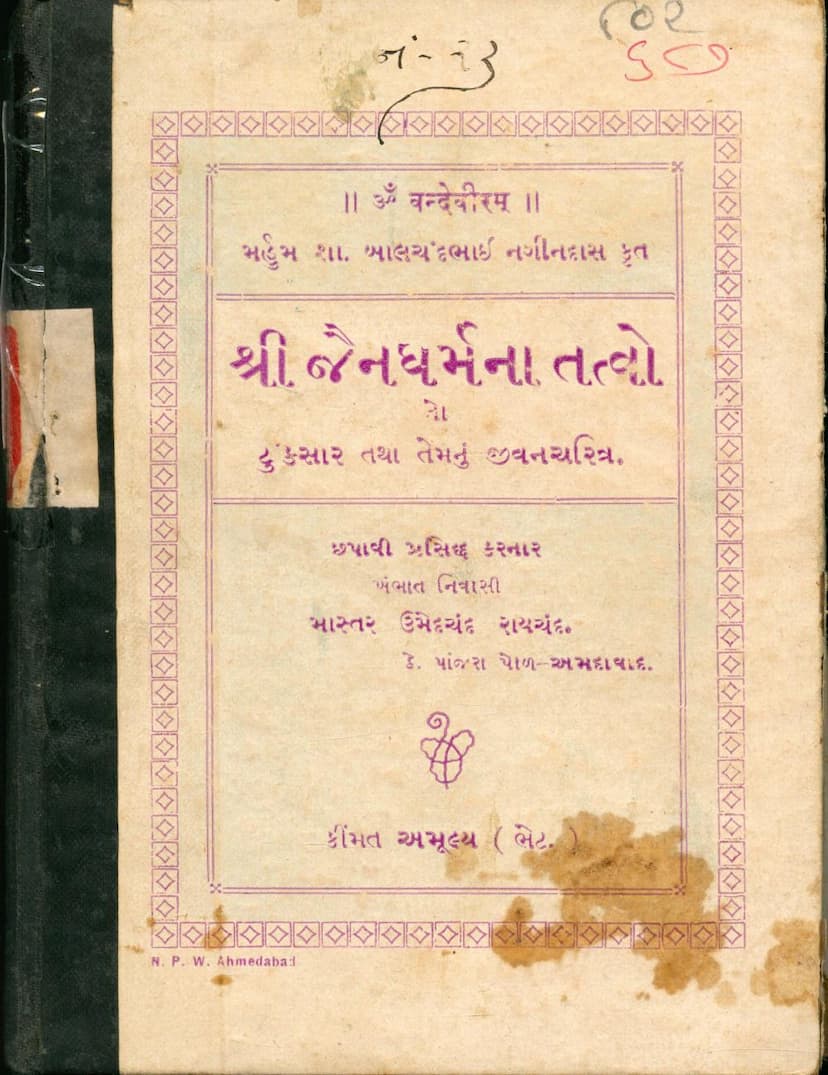Jain Dharmna Tattvo
Added to library: September 2, 2025

Summary
Here's a comprehensive summary of the Jain text "Jain Dharmna Tattvo" by Shah Balchandbhai Nagindas, based on the provided pages:
Book Title: Jain Dharmna Tattvo (Principles of Jainism) Author: Shah Balchandbhai Nagindas (late) Publisher/Compiler: Master Umedchand Raichand, resident of Khambhat, associated with Panjra Pol, Ahmedabad. Sponsor: Shah Vadilal Balabhai Jarivala, resident of Khambhat. Year of Publication: Vira Samvat 2449, Vikrama Samvat 1979 (1923 CE).
Overview:
This book, "Jain Dharmna Tattvo," is a compilation of the essential principles of Jainism, presented in a concise manner. It also includes a biography of the original compiler, the late Shah Balchandbhai Nagindas. The book was published through the desire and financial support of his son, Vadilal Balabhai Jarivala, and made available as a gift to interested individuals.
Content Summary:
The book aims to provide a foundational understanding of Jain philosophy and practices. The table of contents (Vishayanukramanika) reveals a wide range of topics covered, indicating a comprehensive approach to Jain tenets. The key areas and themes explored in the book include:
-
Author's Biography (Balchandbhai Nagindas): The book begins with the biography of Balchandbhai Nagindas, detailing his life journey, family background, business ventures, personal life events (like widowhood), and his spiritual awakening. It highlights his transition from a worldly life to a more religious pursuit, driven by his experiences and association with ascetics. His dedication to religious study, starting with basic rituals and progressing to complex philosophical texts like Jiv Vichar, Nav Tattva, and Karma Granth, is emphasized.
-
Core Jain Principles:
- Karma Siddhanta: A significant portion of the book delves into the principles of Karma, explaining how living beings (Jivas) bind karmic matter (Pudgala) through various passions and actions. The nature of Karma, its pervasiveness, and the Jiva's role as its agent and experiencer are discussed.
- The Nature of the Soul (Jiva): The book explains the soul as an eternal, formless, conscious entity with inherent qualities of infinite knowledge, perception, bliss, and energy. It clarifies the distinction between the soul and the physical body, akin to a sword and its sheath.
- Dravya (Substances): The six fundamental substances of Jainism are introduced and explained, including Dharma (medium of motion), Adharma (medium of rest), Akash (space), Kala (time), Pudgala (matter), and Jiva (soul).
- Samsara (The Cycle of Existence): The transient and illusory nature of the worldly existence is described, comparing it to dreams or illusions. The book emphasizes that all worldly possessions and relationships are temporary.
- Leshyas: The six types of mental states (Kṛṣṇa, Nīla, Kāpota, Tejas, Padma, Śukla) are explained, illustrating how mental disposition affects one's perception and outward appearance.
- Jiva Vichar (Analysis of Souls): A detailed classification of souls is provided, including the distinction between mobile (Trasa) and immobile (Sthavara) souls. The five types of immobile souls (earth-bodied, water-bodied, fire-bodied, air-bodied, and vegetation-bodied) are described, with further subcategories. The four types of mobile souls (two-sensed, three-sensed, four-sensed, and five-sensed) are also detailed, along with their respective habitats (heavenly beings, humans, animals, and hellish beings).
- Gods (Devata): The book provides a comprehensive classification of heavenly beings into four categories: Bhuvanpati, Vyantar, Jyotishi, and Vaimanika, along with detailed descriptions of their dwellings, lineages, and numbers.
- Hellish Beings (Naraki): The seven hells are described, including their structure, duration of life, and the intense suffering experienced by their inhabitants, categorized into three types of pain: Kṣetra Vedana (location-based pain), Anyānya Kr̥ta Vedana (pain inflicted by other hellish beings), and Paramadhāmi Kr̥ta Vedana (pain inflicted by specific punishing deities).
- The Universe (Chaud Raj Lok): The structure of the Jain universe, divided into three realms (Urdhva Lok, Tiryak Lok, and Adho Lok), is explained with dimensional details and the concept of 'Lokant' (boundaries of the universe).
- Nav Tattva (The Nine Fundamentals): The book outlines the nine fundamental principles of Jainism: Jiva (soul), Ajiva (non-soul), Asrava (influx of karma), Samvara (cessation of karma influx), Bandha (bondage of karma), Nirjara (shedding of karma), Punya (merit), Papa (demerit), and Moksha (liberation).
- Karma Prakriti: An extensive explanation of the 8 types of Karma and their 158 subtypes (Uttar Prakriti) is provided, detailing their nature, causes of bondage, and the stages of their influence (bandha, udaya, udīraṇā, satta).
- Stages of Spiritual Progress (Guna Sthana): The fourteen stages of spiritual development, from the state of utter delusion (Mithyatva) to complete liberation (Samyogi Kevali and Ayogi Kevali), are explained, detailing how karmic bondage and liberation occur at each stage.
- The Goal of Moksha: The ultimate aim of Jainism, the liberation of the soul from the cycle of birth and death, is presented as the state of infinite knowledge, perception, bliss, and energy.
-
Author's Spiritual Journey: The narrative of Balchandbhai's life highlights a profound personal transformation. Initially engaged in worldly pursuits, his encounter with widowhood spurred a spiritual quest. He diligently studied Jain scriptures, engaged in ascetic practices (tapascharya), and eventually took upon himself the task of compiling these essential principles for the benefit of others.
-
Compilation and Publication: Master Umedchand Raichand, the publisher, played a crucial role in editing and compiling the late Balchandbhai's notes, ensuring clarity and completeness based on his understanding. The book's publication was an act of devotion and a contribution to the Jain community, aiming to spread knowledge and foster spiritual growth.
-
Invitation to Readers: Readers are encouraged to obtain the book by sending a nominal postage fee (four annas), emphasizing its value as a spiritual resource for all seekers of Jainism.
Overall Purpose:
"Jain Dharmna Tattvo" serves as an accessible guide to the core teachings of Jainism. It aims to educate individuals about the nature of the soul, the workings of karma, the path to liberation, and the principles that guide a virtuous life according to Jain philosophy. The book is presented as a means for readers to develop faith (Samakit) and progress on the path to spiritual liberation (Moksha).